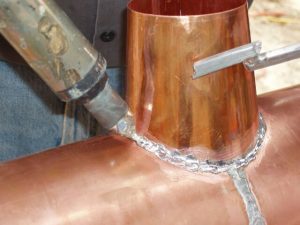Basic Operations in Soldering
For making soldered joints, following operations are required to be performed sequentially.
1. Shaping and fitting of metal parts together
Filler metal on heating flows between the closely placed adjacent surfaces due to capillary action, thus, closer the parts the more is solder penetration. This means that the two parts should be shaped to fit closely so that the space between them is extremely small to be filled completely with solder by the capillary action. If a large gap is present, capillary action will not take place and the joint will not be strong.
2. Cleaning of surfaces
This is done to remove dirt, grease or any other foreign material from the surface pieces to be soldered, in order to get a sound joint. If surfaces are not clean, strong atomic bonds will not form.
3. Flux application
Soldering cannot be done without a flux. Even if a metal is clean, it rapidly acquires an oxide film of submicroscopic thickness due to heat and this film insulates the metal from the solder, preventing the surface to get wetted by solder. This film is broken and removed by the flux. The flux is applied when parts are ready for joining.
4. Application of heat and solder
The parts must be held in a vice or with special work holding devices so that they do not move while soldering. The parts being soldered must be heated to solder-melting and solder-alloying temperature before applying the solder for soldering to take place the assembly so that the heat is most effectively transmitted to the being soldered.
As soon as the heat is applied, the flux quickly breaks down the oxide film (the insulating oxide layer barrier between the surface and solder). Now solder is applied which immediately
melts and metal to metal contact is established through the medium of molten solder. Finally, the surplus solder is removed and the joint is allowed to cool. Blow torches dipping the parts in molten solder or other methods are also used for soldering.
Source A Textbook of Basic Manufacturing Processes and Workshop Technology by Rajender Singh.













Post Comment
You must be logged in to post a comment.